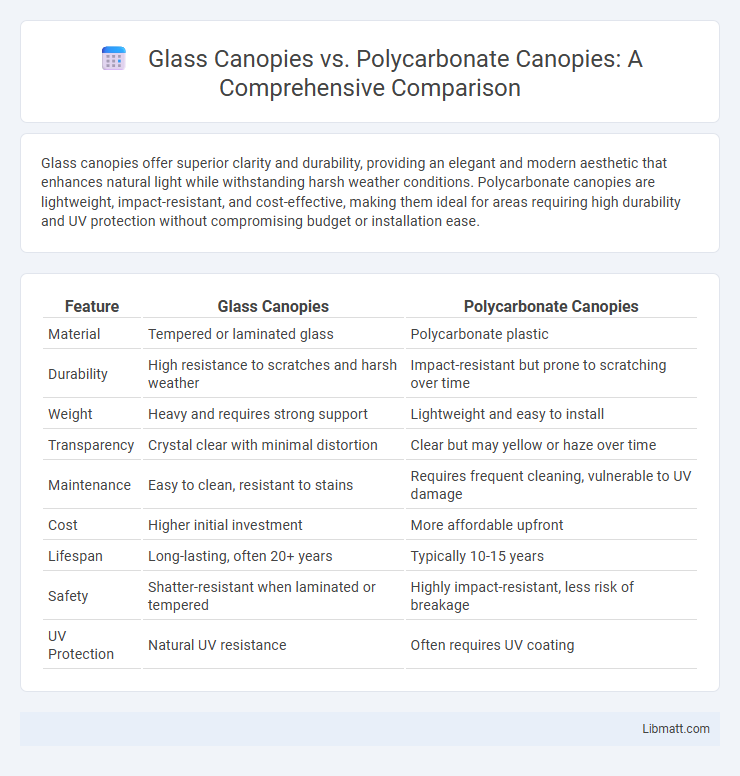Glass canopies offer superior clarity and durability, providing an elegant and modern aesthetic that enhances natural light while withstanding harsh weather conditions. Polycarbonate canopies are lightweight, impact-resistant, and cost-effective, making them ideal for areas requiring high durability and UV protection without compromising budget or installation ease.
Table of Comparison
| Feature | Glass Canopies | Polycarbonate Canopies |
|---|---|---|
| Material | Tempered or laminated glass | Polycarbonate plastic |
| Durability | High resistance to scratches and harsh weather | Impact-resistant but prone to scratching over time |
| Weight | Heavy and requires strong support | Lightweight and easy to install |
| Transparency | Crystal clear with minimal distortion | Clear but may yellow or haze over time |
| Maintenance | Easy to clean, resistant to stains | Requires frequent cleaning, vulnerable to UV damage |
| Cost | Higher initial investment | More affordable upfront |
| Lifespan | Long-lasting, often 20+ years | Typically 10-15 years |
| Safety | Shatter-resistant when laminated or tempered | Highly impact-resistant, less risk of breakage |
| UV Protection | Natural UV resistance | Often requires UV coating |
Introduction to Glass and Polycarbonate Canopies
Glass canopies offer high transparency and sleek aesthetics, making them ideal for modern architectural designs where natural light and visual appeal are crucial. Polycarbonate canopies provide exceptional impact resistance and lightweight durability, suitable for areas requiring robust protection against weather and physical damage. Both materials serve distinct purposes, with glass favored for elegance and polycarbonate preferred for strength and versatility.
Material Overview: Glass vs Polycarbonate
Glass canopies offer exceptional clarity and durability with high scratch resistance, making them ideal for permanently fixed structures requiring a premium aesthetic. Polycarbonate canopies provide superior impact resistance and lightweight flexibility, suitable for areas prone to strong weather conditions or where ease of installation is a priority. Your choice between these materials depends on balancing durability, maintenance, and budget preferences.
Aesthetic Appeal and Design Flexibility
Glass canopies offer a sleek, modern aesthetic with crystal-clear transparency, enhancing natural light and providing a luxurious look ideal for contemporary architectural designs. Polycarbonate canopies boast exceptional design flexibility due to their lightweight, impact-resistant properties, allowing for creative shapes and color variations that suit diverse styles and functional needs. Choosing between these materials depends on your preference for premium visual clarity versus adaptable design possibilities.
Durability and Weather Resistance
Glass canopies offer excellent durability with high resistance to scratches and a longer lifespan under UV exposure, making them ideal for harsh weather conditions. Polycarbonate canopies provide superior impact resistance and flexibility, enabling them to withstand heavy rain, hail, and strong winds without cracking. Your choice depends on prioritizing either the robust, long-lasting clarity of glass or the resilient, lightweight nature of polycarbonate for effective weather protection.
Maintenance Requirements
Glass canopies require regular cleaning to maintain clarity and may need occasional inspection for cracks or sealant degradation to prevent leaks. Polycarbonate canopies demand less frequent maintenance due to their impact resistance and UV protection, but they should be cleaned with non-abrasive materials to avoid surface scratches. Your choice between the two will impact the time and effort spent on upkeep, with polycarbonate often offering a more convenient maintenance experience.
Light Transmission and UV Protection
Glass canopies offer superior light transmission, typically allowing up to 90% of natural light to pass through, creating a clear, bright environment. Polycarbonate canopies, while providing slightly less light transmission at around 80-85%, excel in UV protection by blocking up to 99.9% of harmful ultraviolet rays, reducing fading and skin damage risks. Both materials balance daylight exposure and UV shielding, but polycarbonate is preferred for enhanced UV defense without significantly compromising brightness.
Cost Comparison: Installation and Long-term Value
Glass canopies generally have higher installation costs due to their weight and the need for specialized mounting hardware, while polycarbonate canopies offer a more budget-friendly option with easier installation. Over time, glass provides superior durability and scratch resistance, leading to lower maintenance expenses, whereas polycarbonate may require more frequent replacement due to its susceptibility to UV damage and discoloration. Considering long-term value, glass canopies often present a better investment through their longevity despite the upfront expense.
Safety and Impact Resistance
Glass canopies offer high aesthetic appeal and excellent scratch resistance but tend to be more brittle and prone to shattering upon significant impact, posing potential safety risks. Polycarbonate canopies provide superior impact resistance, absorbing shocks without breaking and significantly enhancing safety in high-traffic or extreme weather conditions. Their lightweight yet durable nature makes polycarbonate canopies a preferred choice where impact resistance and occupant safety are critical.
Energy Efficiency Considerations
Glass canopies provide superior insulation and natural light transmission, reducing the need for artificial lighting and lowering energy consumption in your space. Polycarbonate canopies offer good UV protection but typically have lower thermal insulation properties, which may result in higher cooling or heating costs. Choosing glass canopies enhances energy efficiency by balancing durability and thermal performance for sustainable temperature regulation.
Best Applications and Use Cases
Glass canopies excel in architectural applications requiring high aesthetic appeal, such as commercial entrances, terraces, and upscale residential balconies, due to their clarity, durability, and premium finish. Polycarbonate canopies are best suited for environments needing impact resistance and lightweight solutions, including walkways, carports, and industrial settings where UV protection and weather resistance are critical. Both materials offer weather shielding, but polycarbonate is preferred in areas prone to hail or strong winds, while glass is favored for its superior translucency and elegance.
Glass canopies vs polycarbonate canopies Infographic

 libmatt.com
libmatt.com